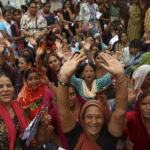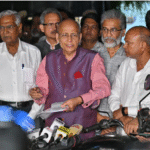In a significant political development in India’s northeastern region, the ruling parties in Arunachal Pradesh and Sikkim have secured decisive victories, ensuring their continued hold on power. These wins come amidst a backdrop of high voter turnout, vibrant campaigns, and key issues that resonate deeply with the electorate. This article explores the recent electoral triumphs in these states, examining the factors that contributed to these victories, the implications for the future, and the human stories behind the political landscape.
Arunachal Pradesh: A Resounding Victory for BJP
The Electoral Landscape
In Arunachal Pradesh, the Bharatiya Janata Party (BJP) has emerged victorious, reaffirming its dominance in the state’s political arena. The election was marked by a high voter turnout of over 80%, reflecting the electorate’s engagement and enthusiasm. The BJP’s campaign was robust, focusing on development, infrastructure, and local issues that struck a chord with the voters.
Key Factors Behind the Victory
Development and Infrastructure
The BJP’s focus on development projects, such as the construction of roads, bridges, and connectivity initiatives, has been a significant factor in its success. Over the past few years, the state has witnessed substantial infrastructure development, improving the quality of life for many residents. These tangible improvements have bolstered the party’s credibility and appeal.
Local Leadership
The charismatic leadership of Chief Minister Pema Khandu has also played a crucial role in the BJP’s victory. Khandu’s approachable demeanor, combined with his commitment to addressing local issues, has earned him widespread support. His efforts in promoting education, healthcare, and economic opportunities have resonated with the electorate, solidifying his position as a trusted leader.  for more information click on this link
for more information click on this link
National Policies
National policies and schemes introduced by the central BJP government, such as the Pradhan Mantri Awas Yojana (PMAY) and the Pradhan Mantri Gram Sadak Yojana (PMGSY), have also contributed to the party’s success. These schemes have brought tangible benefits to rural and urban areas alike, enhancing the BJP’s image as a party that delivers on its promises.
Voter Voices
For many voters in Arunachal Pradesh, the decision to support the BJP was driven by a desire for continued progress and stability. Lobsang Tsering, a farmer from Tawang, expressed his satisfaction with the government’s efforts: “The new roads have made it much easier to transport our produce to the market. We feel connected to the rest of the state now. The BJP has done a lot for us, and we want to see more of this development.”
Similarly, Nyishi tribal community leader Tashi Phuntsok highlighted the importance of local representation: “Chief Minister Khandu understands our issues and has always been accessible. His commitment to preserving our culture while pushing for development has been commendable. We trust him to lead us forward.”
Sikkim: SDF’s Triumphant Return
The Electoral Landscape
In Sikkim, the Sikkim Democratic Front (SDF) has staged a remarkable comeback, reclaiming power after a brief period out of office. The election saw a voter turnout of 75%, indicating strong civic participation. The SDF’s campaign emphasized stability, economic development, and addressing the unique challenges faced by the state.
Key Factors Behind the Victory
Economic Development
The SDF’s emphasis on economic development and sustainable tourism has been pivotal in its electoral success. Sikkim’s economy heavily relies on tourism, and the SDF’s policies to promote eco-friendly tourism and organic farming have struck a chord with the electorate. The party’s commitment to environmental sustainability aligns with the state’s identity as a green and organic state.
Social Welfare Programs
The SDF’s focus on social welfare programs, including healthcare, education, and women’s empowerment, has resonated with voters. The party has introduced various initiatives aimed at improving healthcare infrastructure, providing scholarships for students, and supporting women’s self-help groups. These efforts have garnered significant support, particularly among marginalized communities.
Leadership and Vision
Pawan Chamling, the veteran leader of the SDF, has been instrumental in the party’s resurgence. His long tenure as Chief Minister and his vision for Sikkim’s development have established him as a respected and influential figure. Chamling’s promises to address unemployment, enhance infrastructure, and promote social harmony have been well-received by the electorate.
Voter Voices
For many voters in Sikkim, the decision to support the SDF was influenced by the party’s track record and Chamling’s leadership. Sonam Lhamo, a teacher from Gangtok, shared her views: “The SDF has always prioritized education and healthcare. Under Chamling’s leadership, we have seen significant improvements in our schools and hospitals. We trust him to continue these efforts.”
Karma Bhutia, a tour operator in Pelling, emphasized the importance of sustainable tourism: “Tourism is our lifeline, and the SDF’s policies to promote eco-tourism have been beneficial. We need a government that understands the importance of balancing development with environmental conservation. Chamling and the SDF have a clear vision for this.”
Implications for the Future
The electoral victories in Arunachal Pradesh and Sikkim carry significant implications for the future, both at the state and national levels.
Stability and Continuity
The return of the BJP in Arunachal Pradesh and the SDF in Sikkim suggests a desire among voters for stability and continuity. Both states have experienced periods of political volatility, and the recent elections reflect a preference for experienced leadership and proven governance.
Focus on Development
The emphasis on development and infrastructure in both states indicates that economic progress remains a top priority for the electorate. Continued investment in infrastructure, healthcare, education, and tourism will be essential for sustaining growth and improving the quality of life for residents.
Regional Dynamics
The victories also highlight the unique regional dynamics in India’s northeastern states. Local issues, cultural identity, and leadership play a crucial role in shaping electoral outcomes. National parties like the BJP must continue to address regional concerns and engage with local leaders to maintain their influence.
National Impact
At the national level, the victories in Arunachal Pradesh and Sikkim bolster the positions of the BJP and the SDF. For the BJP, maintaining control in Arunachal Pradesh strengthens its foothold in the northeast, a region of strategic importance. For the SDF, reclaiming power in Sikkim reinforces its relevance and sets the stage for future political engagements.
Challenges Ahead
Despite the electoral successes, both states face significant challenges that will require sustained attention and effort.
Arunachal Pradesh
In Arunachal Pradesh, addressing infrastructure gaps, ensuring equitable development, and managing environmental concerns will be critical. The state’s diverse ethnic composition and remote geography present unique challenges that require inclusive and sensitive governance.
Sikkim
In Sikkim, balancing economic development with environmental conservation will be a key challenge. As tourism continues to grow, maintaining the state’s ecological integrity and promoting sustainable practices will be essential. Additionally, addressing unemployment and enhancing social welfare programs will be vital for inclusive growth.
Conclusion: A Tale of Two States
The electoral victories in Arunachal Pradesh and Sikkim are a testament to the power of effective governance, strong leadership, and the ability to address local issues. The BJP’s continued dominance in Arunachal Pradesh and the SDF’s resurgence in Sikkim reflect the electorate’s desire for stability, development, and visionary leadership.
As both states move forward, the focus will be on translating electoral promises into tangible outcomes. The challenges are significant, but so are the opportunities. With the right policies and sustained efforts, Arunachal Pradesh and Sikkim can continue to progress, ensuring a better future for their residents.
In the end, the stories of these victories are not just about political parties or leaders. They are about the people—farmers, teachers, entrepreneurs, and community leaders—who strive for a better life and a brighter future. Their hopes, aspirations, and voices are at the heart of these electoral outcomes, and it is their journey that will shape the future of Arunachal Pradesh and Sikkim. ALSO READ:- South Africa’s ANC to Start Coalition Talks with Other Parties to Form Government 2024




